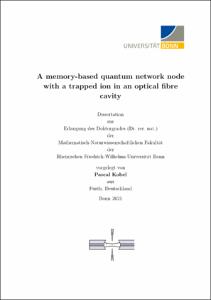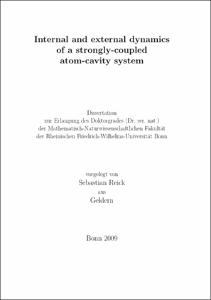Tepaske, Maurits Sebastiaan Joseph: Modern techniques and applications for (imaginary-)time evolution of quantum spin systems. - Bonn, 2024. - Dissertation, Rheinische Friedrich-Wilhelms-Universität Bonn.
Online-Ausgabe in bonndoc: https://nbn-resolving.org/urn:nbn:de:hbz:5-76485
Online-Ausgabe in bonndoc: https://nbn-resolving.org/urn:nbn:de:hbz:5-76485
@phdthesis{handle:20.500.11811/11593,
urn: https://nbn-resolving.org/urn:nbn:de:hbz:5-76485,
author = {{Maurits Sebastiaan Joseph Tepaske}},
title = {Modern techniques and applications for (imaginary-)time evolution of quantum spin systems},
school = {Rheinische Friedrich-Wilhelms-Universität Bonn},
year = 2024,
month = jun,
note = {Causality is at the core of physics, with any physical phenomena boiling down to a sequence of states related by causality. If the sequence is repeating itself, it is in equilibrium, whereas a changing sequence indicates a dynamical non-equilibrium process, where a state is being reconfigured according to the forces that act on it. In the context of quantum many-body physics, we consider quantum particles that exert forces on each other, such that initializing the particles in a particular state and then leaving them to themselves can result in a complex dynamical process. This induces a notion of time, which is elegantly captured by the Hamiltonian formulation of mechanics. Here, a recipe for the time evolution of a state follows immediately from the interactions of the particles.
All potential sequences of states that can be generated by the interactions can be encoded into a fundamental object: The time-evolution operator. It maps any state to a time-evolved state, making it the starting point for any simulation algorithm. On a classical computer, the simulation of quantum many-body systems is inherently limited, with many interesting phenomena out of reach. Nonetheless, by approximating the time-evolution operator we can still consider particular cases in great detail. Alternatively, we could use a quantum computer, where quantum time evolution is performed naturally. Also here, controlled approximations of the time-evolution operator are crucial. But this technology is still in an early stage of development, leaving many areas where classical simulation methods are still unrivaled.
In this thesis we will explore various approximation schemes for the time-evolution operator, with applications that range from the finite-temperature equilibrium physics of large experimentally-realizable magnets, to the zero-temperature non-equilibrium physics of small quantum computers. Along the way, we will naturally be driven to test the limits of the approximations. We want to know: How high can we get the accuracy for a fixed number of computational resources? We will use numerical optimization to determine approximations with higher accuracy than any known analytical approximation. This is of utmost concern for modern-day quantum computers, as well as modern classical algorithms that deal with highly-entangled states.
Each chapter is focused on a specific aspect of time evolution, where the machinery is developed and a survey is made of its applications. Each chapter apart from the introduction is furthermore accompanied by one or two published articles, where the subject matter is further developed in novel ways and applied to the simulation of condensed-matter systems.},
url = {https://hdl.handle.net/20.500.11811/11593}
}
urn: https://nbn-resolving.org/urn:nbn:de:hbz:5-76485,
author = {{Maurits Sebastiaan Joseph Tepaske}},
title = {Modern techniques and applications for (imaginary-)time evolution of quantum spin systems},
school = {Rheinische Friedrich-Wilhelms-Universität Bonn},
year = 2024,
month = jun,
note = {Causality is at the core of physics, with any physical phenomena boiling down to a sequence of states related by causality. If the sequence is repeating itself, it is in equilibrium, whereas a changing sequence indicates a dynamical non-equilibrium process, where a state is being reconfigured according to the forces that act on it. In the context of quantum many-body physics, we consider quantum particles that exert forces on each other, such that initializing the particles in a particular state and then leaving them to themselves can result in a complex dynamical process. This induces a notion of time, which is elegantly captured by the Hamiltonian formulation of mechanics. Here, a recipe for the time evolution of a state follows immediately from the interactions of the particles.
All potential sequences of states that can be generated by the interactions can be encoded into a fundamental object: The time-evolution operator. It maps any state to a time-evolved state, making it the starting point for any simulation algorithm. On a classical computer, the simulation of quantum many-body systems is inherently limited, with many interesting phenomena out of reach. Nonetheless, by approximating the time-evolution operator we can still consider particular cases in great detail. Alternatively, we could use a quantum computer, where quantum time evolution is performed naturally. Also here, controlled approximations of the time-evolution operator are crucial. But this technology is still in an early stage of development, leaving many areas where classical simulation methods are still unrivaled.
In this thesis we will explore various approximation schemes for the time-evolution operator, with applications that range from the finite-temperature equilibrium physics of large experimentally-realizable magnets, to the zero-temperature non-equilibrium physics of small quantum computers. Along the way, we will naturally be driven to test the limits of the approximations. We want to know: How high can we get the accuracy for a fixed number of computational resources? We will use numerical optimization to determine approximations with higher accuracy than any known analytical approximation. This is of utmost concern for modern-day quantum computers, as well as modern classical algorithms that deal with highly-entangled states.
Each chapter is focused on a specific aspect of time evolution, where the machinery is developed and a survey is made of its applications. Each chapter apart from the introduction is furthermore accompanied by one or two published articles, where the subject matter is further developed in novel ways and applied to the simulation of condensed-matter systems.},
url = {https://hdl.handle.net/20.500.11811/11593}
}









